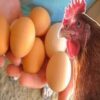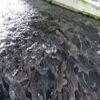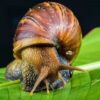The pericarp of nutmeg, scientifically known as Myristica fragrans, encapsulates the seed within a fruit that resembles a large apricot. This pericarp develops from the ovary wall of the flower after fertilization occurs. It is classified as a drupe, which is a type of fruit characterized by a hard endocarp surrounding a single seed.
The outermost layer of the pericarp is the exocarp, which appears smooth and waxy, ranging in color from yellow to red as it ripens. This outer layer provides protection and aids in seed dispersal.
Beneath the exocarp lies the mesocarp, a thick, fleshy layer that contains high levels of secondary metabolites such as phenolic compounds and carotenoids. These compounds contribute to the fruit’s coloration and flavor profile. The mesocarp’s composition also includes water and various sugars, which give nutmeg its characteristic sweet taste.
Moving inward, the endocarp forms a tough, woody shell around the seed. This shell is responsible for protecting the embryonic seed and is often very hard and difficult to crack open without specialized tools. The endocarp’s toughness ensures that the seed remains undamaged during its journey through the digestive system of animals that consume the fruit, thereby aiding in seed dispersal.
Inside the endocarp lies the seed itself, which is the primary target for nutmeg harvesting. This seed is surrounded by a red, net-like aril known as mace. Mace is highly aromatic and is harvested separately from the seed for use as a spice and flavoring agent.
The pericarp of nutmeg plays a crucial role in the plant’s reproductive cycle and survival strategy. By enclosing the seed within layers of protective tissue, the pericarp ensures that the seed has the best possible chance of germinating and producing a new plant. Additionally, the pericarp’s chemical composition, particularly the presence of secondary metabolites, contributes to the fruit’s taste, aroma, and potential health benefits.
The nutmeg pericarp is a multifaceted structure that serves both protective and reproductive functions within the life cycle of the nutmeg tree. Its layers provide physical protection for the developing seed and contribute to the fruit’s sensory qualities. Understanding the anatomy and composition of the nutmeg pericarp enhances appreciation for this spice’s botanical complexity and its role in human culture and cuisine
The Economic Importance and Uses of Nutmeg Pericarp

1. Animal Feed: The fibrous nature of nutmeg pericarp makes it an excellent component in animal feed, providing essential nutrients.
2. Biofuel: The high calorific value of the pericarp makes it suitable for biofuel production, helping to reduce dependency on fossil fuels.
3. Organic Fertilizer: Composting nutmeg pericarp creates a rich organic fertilizer, enhancing soil fertility and promoting sustainable agriculture.
4. Essential Oils: Nutmeg pericarp contains essential oils used in aromatherapy and perfumery, valued for their pleasant aroma and therapeutic properties.
5. Food Preservatives: The antimicrobial properties of the pericarp are used in food preservation, extending the shelf life of various products.
6. Natural Dye: Extracts from the pericarp are used as natural dyes in textiles and cosmetics, offering a safer alternative to synthetic dyes.
7. Cosmetics: Nutmeg pericarp is used in skincare products for its anti-inflammatory and antioxidant properties, promoting healthy skin.
8. Pharmaceuticals: The pericarp contains compounds with medicinal properties, used in traditional and modern medicine to treat various ailments.
9. Insect Repellent: The natural compounds in the pericarp act as effective insect repellents, used in sprays and lotions.
10. Pesticides: Natural pesticides derived from nutmeg pericarp help in organic farming by controlling pests without harmful chemicals.
11. Flavoring Agents: The pericarp is used as a flavoring agent in the food and beverage industry, enhancing the taste of various products.
12. Traditional Medicine: In traditional medicine, nutmeg pericarp is used for its anti-inflammatory and digestive benefits.
13. Herbal Teas: Dried and powdered nutmeg pericarp is used in herbal teas, providing a unique flavor and health benefits.
14. Livestock Bedding: The fibrous pericarp is used as bedding material for livestock, improving hygiene and comfort.
15. Soil Conditioner: Nutmeg pericarp improves soil structure and water retention when used as a soil conditioner.
16. Industrial Absorbents: The pericarp’s absorbent nature makes it useful in industrial applications for absorbing spills and waste.
17. Packaging Material: Biodegradable packaging materials are made from nutmeg pericarp, reducing plastic waste.
18. Culinary Uses: The pericarp is used in culinary applications for its unique flavor and aroma, particularly in baked goods and sauces.
Read Also: The Most Lucrative between Production of Fish Fingerlings or Raising them to Table Size
The Products and By-products That Can Be Derived From Nutmeg Pericarp

1. Essential Oil: Extracted through steam distillation, used in perfumes and aromatherapy.
2. Nutmeg Butter: Obtained by cold pressing, used in cooking and skincare products.
3. Nutmeg Powder: Dried and ground pericarp used as a spice in cooking.
4. Compost: Produced by composting the pericarp, used as organic fertilizer.
5. Biochar: Created through pyrolysis, used as a soil amendment and carbon sequestration agent.
6. Natural Dye: Extracted through water or alcohol, used in textiles and cosmetics.
7. Herbal Extracts: Produced using solvent extraction, used in pharmaceuticals and supplements.
8. Livestock Feed: Processed into pellets or mash, providing nutritional benefits to animals.
9. Insect Repellent: Formulated into sprays or lotions, used to repel insects.
10. Bioplastic: Manufactured using the fibrous pericarp, used in sustainable packaging solutions.
11. Natural Pesticide: Extracted and formulated into sprays, used in organic farming.
12. Flavoring Agent: Extracted and concentrated, used in the food and beverage industry.
13. Antimicrobial Agents: Derived from the pericarp, used in food preservation and medical applications.
14. Organic Mulch: Produced by shredding the pericarp, used in gardening and landscaping.
15. Animal Bedding: Processed into soft, absorbent material for livestock.
16. Herbal Tea Blends: Dried and mixed with other herbs, used in tea production.
17. Industrial Absorbents: Processed into absorbent pads or powders, used for spill management.
Read Also: The Best Stage to Start Raising your Catfishes (Fingerlings or Juveniles)
Frequently Asked Questions (FAQ’s) About Nutmeg Pericarp

1. What is nutmeg pericarp?
Nutmeg pericarp is the outer covering of the nutmeg seed, known for its fibrous texture and various uses.
2. How is nutmeg pericarp used in traditional medicine?
In traditional medicine, nutmeg pericarp is used for its anti-inflammatory, digestive, and antimicrobial properties.
3. Can nutmeg pericarp be used in cosmetics?
Yes, nutmeg pericarp is used in skincare products for its anti-inflammatory and antioxidant properties.
4. What are the industrial uses of nutmeg pericarp?
Nutmeg pericarp is used in biofuel production, as an industrial absorbent, and in biodegradable packaging.
5. How is nutmeg pericarp beneficial in agriculture?
It is used as organic fertilizer, soil conditioner, natural pesticide, and livestock feed.
6. What are the culinary uses of nutmeg pericarp?
It is used as a flavoring agent in cooking, particularly in baked goods and sauces.
7. How is nutmeg pericarp processed into essential oil?
Nutmeg pericarp essential oil is extracted through steam distillation.
8. What products can be made from nutmeg pericarp in the cosmetics industry?
Products include skincare creams, lotions, and natural dyes for makeup.
9. How does nutmeg pericarp contribute to sustainable practices?
It is used in biofuel, biodegradable packaging, and as a component in organic farming, reducing environmental impact.
10. Is nutmeg pericarp safe for use in animal feed?
Yes, it provides essential nutrients and is used as a component in animal feed and bedding.
Read Also: What to Know About Kokedama





